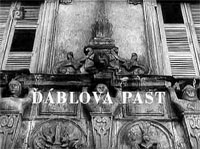 Ďáblova past.
Ďáblova past.
Czechoslovakia, 1961, black and white, 87 mins
František Vláčil’s second feature was the first of a loose trilogy set in the distant past. All three films (the others being Marketa Lazarová and The Valley of the Bees/Údolí včel, both 1967) take place at a time of fundamental ideological conflict and upheaval – in the case of The Devil’s Trap, it’s sixteenth-century Bohemia at the time of the Counter-Reformation, the period of Catholic revival that lasted just over a century between 1545 and 1648. As the film reveals, the Inquisition’s targets ranged wider than just the burgeoning Protestant movement, encompassing anyone deemed to be allied to an alternative supernatural agency.
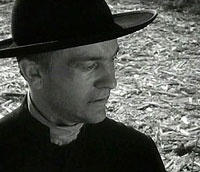
The film opens with a series of dissonant a cappella chords (instantly recognisable as the work of Zdeněk Liška, who would remain Vláčil’s regular composer until the late 1970s), and an equally striking image of a gnarled effigy of Christ, dominating a barren landscape so completely that one might initially miss the minuscule human figure in the distance. The message is clear: God holds sway over man, and woe betide anyone who challenges the status quo, regardless of whether that’s the specific intention.
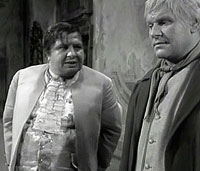
The conflict that drives the film begins when Regent Valecský of Valce, an overbearing, gluttonous buffoon, orders that the ground be dug up for a new barn, a preventative measure in the case of a repeat of the previous year’s devastating drought. However, the miller Spálený expresses concerns that the proposed site is unsuitable. Spálený’s intimate knowledge of the land goes well beyond what his profession would normally require, his extreme sensitivity to topography and climate enabling him to predict everything from the location of wellsprings to the unsuitability of a particular patch of land for raising a barn.
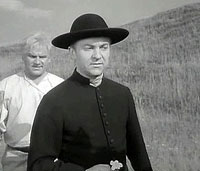
But the fact that he is repeatedly and emphatically proven right is cynically interpreted as confirmation of rumours of a diabolical alliance (which date back to an incident when his grandfather survived an attempted burning by invading Swedes), offering both religious and legal justification for persecution. The precariousness of Spálený’s position is made clear when he breaks up a potentially vicious knife-fight between his son Jan and the gamekeeper Filip, and is rebuked by the Regent for spoiling his entertainment. Similarly, the philosophical gulf between Spálený and the authorities is neatly illustrated by a small but significant semantic shift. When he explains that “the earth speaks”, he’s asked whether this means that he heard voices coming out of the earth: the notion that there might be an entirely natural explanation for physical phenomena is alien to his accusers.
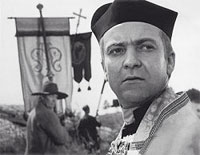
The film’s other principal character is the priest Prokus, a more complex and initially more sympathetic figure than his profession and role in the film as Inquisitorial ambassador might suggest. Though he ultimately proves incapable of interpreting Spálený’s hard-won skill as anything other than a heretical defiance of his Creator, he is nonetheless a more astute politician than the Regent, pointing out that overtly official persecution of Spálený will make him a martyr in the eyes of the villagers, and that it’s best to let them take on the task of “ripping this poisonous weed from the flowering garden of God”. On paper, Prokus’ subsequent rabble-rousing sermon might seem like classic fire-and-brimstone stuff, but it’s delivered with unnervingly calm assurance.
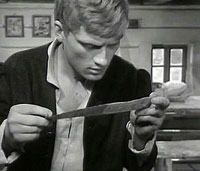
Although not as visually flamboyant as Marketa Lazarová, The Devil’s Trap shows clear signs of the path that Vláčil’s style would shortly take, paying particularly close attention to objects weighted with symbolic significance. Flowers are tossed into a spring and drift with the rippling current, the blade of a scythe is tracked as it slices through wheat, the jug of water that Filip takes to his intended conquest Martina is deemed more important than their faces, while piles of candles are amassed to allow Spálený to work at night (though one is singled out as untouchable, to be lit only when his housekeeper dies – or at least that’s the official reason). A recurring visual motif, a rapid track across the ground to the mill’s front door, establishes common ground between events otherwise a century apart, while the angular skeleton of the emerging barn bears a startlingly close resemblance to the angular, modernist structures in the short Glass Skies (Skleněná oblaka, 1957). The would-be lovers Jan and Martina are repeatedly separated, first by a thick stone wall, and then by the earth itself, as Martina runs through the fields under which Jan traverses a labyrinth of caves and underground reservoirs in search of his now-missing father.
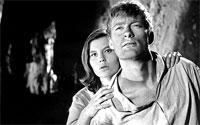
Numerous wordless sequences, accompanied only by natural sounds and/or Liška’s music, celebrate the harvest and the contrast between a decorative sterility of religious procession and the far more basic emotions arising from the miller’s discovery of a fresh wellspring. An overhead shot of a celebratory at the newly-completed barn matches Liška’s multiple-flute accompaniment with an equivalent visual polyphony of dancers, whose primal energy is emphasised by cracks appearing in the ground under their stamping feet. This is not so much an indulgence in magical realism as the first signs of Spálený’s scientifically-justified prophecy reaching fulfilment, though it’s an indication of just how consistently and unsettlingly off-kilter Vláčil’s approach is that such a departure doesn’t seem at all surprising.
- Director: František Vláčil
- Producer: Věra Kadlecová
- Screenplay: František A. Dvořák, Miloš V. Kratochvíl, based on the novel ‘Mill on the Sunken River’ by Alfred Technik
- Photography: Rudolf Milič
- Editors: Miroslav Hájek, Jitka Šulcová
- Design: Karel Škvor
- Sound: František Fabián
- Music: Zdeněk Liška
- Cast: Čestmír Řanda (Regent Valecský of Valce); Vlastimil Hašek (Filip, the gamekeeper); Josef Hlinomaz (the beadle); Karla Chadimová (Martina); Bedřich Karen (Bishop Dittrichštejn); Miroslav Macháček (Prokus, the priest); Jaroslav Moučka (Jakub); Vít Olmer (Jan Spálený); Vítězslav Vejražka (Spálený, the miller); František Kovářík (shepherd); Richard Záhorský (sexton); Viktor Očásek (scribe); František Nechyba (bailiff); Zdeněk Kutil (gamekeeper); Jiřina Bílá (worker); Zlatomír Vacek (vicar); Ladislav Kazda (miller); Dagmar Kofroňová (miller’s wife); Jiří Vršťala (commander)
Links
- České filmové nebe (in Czech)
- Česko-Slovenská filmová databáze (in Czech)
- Internet Movie Database